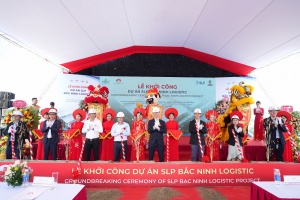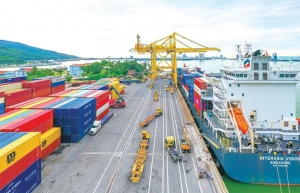Highly-trained workers in demand for logistics field
At the VET International Forum taking place at the end of October, Assoc. Ho Thi Thu Hoa, director of the Vietnam Logistics Research and Development Institute (LRDI), said that the country still needs to add about 2.2 million workers in the industry by the end of the decade, of which at least 200,000 would be high-quality workers with professional expertise.
“Logistics businesses are thirsty for human resources (HR) in all positions,” Hoa said. “Although the demand is great, to be recruited into good positions, workers in addition to professional knowledge also need to meet many criteria such as communication skills, foreign languages, and the ability to adapt to IT.”
Logistics is one of the industries with the fastest growth rate in Vietnam, but strong development also leads to gaps which are related to HR.
 |
| Highly-trained workers in demand for logistics field, illustration photo/ Source: Shutterstock |
According to data from the LRDI, current HR only meet about 10 per cent of the industry’s needs. With 30,000 businesses currently doing business in logistics-related fields, of which over 4,000 businesses are companies with international connection services, the industry is in a state of severe shortage of HR and is in urgent need of access to rapid training and additional training to keep pace with development.
Le Tan Dung, Deputy Minister of Labour, Invalids, and Social Affairs, said that the scale of Vietnam’s logistics market reaches $40-42 billion per year and continues to grow.
“Vietnam’s goal by 2025 is to increase the contribution of logistics services to GDP to 8-10 per cent. HR development is the most important solution to realise this goal,” Dung noted.
Vu Ninh, member of the Board of Directors at Gemadept Group and chairman of the Logistics Industry Reference Council, said that HR is an important factor in promoting the sustainable development of the industry.
“The majority of workers in the logistics industry today come from the vocational training sector, while the ratio of HR between vocational training and university training in Vietnam is unbalanced,” Ninh said. “When vocational training does not ensure enough skills, or there are skills but proficiency levels are not high, this will also lead to low labour productivity.”
Gemadept works in seaports and logistics services with a workforce of 1,500 people. Two-thirds work directly at ports and warehouses, and only one-third have university or Master’s degrees.
According to data from the General Directorate of Vocational Training, the proportion of workers with university training in many countries around the world is lower than the number of workers with vocational training. On average, for every one person studying at university, there will be 2-3 people at college and 3-5 people at intermediate level, but in Vietnam, while 10 people at university, there is only one person at vocational training.
“Each well-trained employee will create high productivity, reduce risks, and bring more benefits to businesses. Gemadept is coordinating with vocational education institutions to strengthen programmes in conjunction with businesses to train skills for logistics workers, helping them elevate their skills and increase their incomes,” said Ninh.
Nguyen Minh Duc, vice rector of Vietnam Maritime University (VMA), said that there are very few people working at logistics enterprises that possess international certificates, such as FIATA diplomas.
“The ability to provide HR from training facilities is still limited due to the shortage of lecturers, practice facilities, payment costs, and incentives for lecturers or scientist in logistics,” Duc said.
VMA is the only institution training bachelor’s degrees in logistics in the northern port city of Haiphong, the largest logistics centre in the north of the country. With a capacity of about 300 students a year and about 1,000 students with majors related to logistics, the facility still cannot meet the needs of local logistics HR.
According to statistics, by 2025, Haiphong will need about 370,000 logistics workers, including more than 252,000 trained workers.
 | SLP commences state-of-the-art logistics facility in Bac Ninh SLP on November 9 officially commenced the development of SLP Bac Ninh Logistic, located inThuan Thanh II Industrial Park, Mao Dien commune, Thuan Thanh district, Bac Ninh province. |
 | SLP Vietnam empowering sustainable development in the logistics sector As an industrial infrastructure developer and GLP’s operational platform in Southeast Asia, SEA Logistics Vietnam (SLP) is making significant strides in integrating sustainability at the core of its business operations. |
 | Danang leverages strategic location for logistics growth With diverse transport infrastructure and a strategic location, Danang has set its sights on becoming a central logistics hub. |
 | Transport advance to activate development The central city of Danang is making compelling efforts in infrastructure development, focusing on projects connecting to industrial zones and promoting interprovincial links. |
What the stars mean:
★ Poor ★ ★ Promising ★★★ Good ★★★★ Very good ★★★★★ Exceptional
Related Contents
Latest News
More News
- Businesses ramp up production as year-end orders surge (December 30, 2025 | 10:05)
- Vietjet chairwoman awarded Labour Hero title (December 29, 2025 | 13:06)
- How to unlock ESG value through green innovation (December 29, 2025 | 10:03)
- AI reshapes media and advertising industry (December 29, 2025 | 08:33)
- FPT and GELEX sign deal to develop blockchain tech for global markets (December 29, 2025 | 08:29)
- Vietnam’s GDP forecast to grow by 9 per cent in 2026 (December 29, 2025 | 08:29)
- Women entrepreneurs are key to Vietnam’s economic growth (December 29, 2025 | 08:00)
- Vietnam's top 500 value-creating enterprises announced (December 27, 2025 | 08:00)
- The PAN Group shaping a better future with ESG strategy (December 26, 2025 | 09:00)
- Masan Consumer officially lists on HSX, marking the next phase of value creation (December 25, 2025 | 13:20)

 Tag:
Tag:





















 Mobile Version
Mobile Version